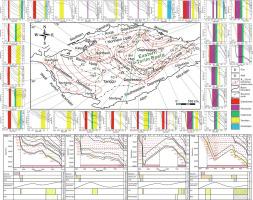当前位置:
X-MOL 学术
›
J. Asian Earth Sci.
›
论文详情
Our official English website, www.x-mol.net, welcomes your
feedback! (Note: you will need to create a separate account there.)
Tectono-thermal evolution of Cambrian–Ordovician source rocks and implications for hydrocarbon generation in the Tarim Basin, NW China
Journal of Asian Earth Sciences ( IF 2.7 ) Pub Date : 2020-06-01 , DOI: 10.1016/j.jseaes.2020.104267 Peng Yang , Guanghui Wu , Zhanli Ren , Renjie Zhou , Jianxin Zhao , Liping Zhang
Journal of Asian Earth Sciences ( IF 2.7 ) Pub Date : 2020-06-01 , DOI: 10.1016/j.jseaes.2020.104267 Peng Yang , Guanghui Wu , Zhanli Ren , Renjie Zhou , Jianxin Zhao , Liping Zhang

|
Abstract The tectono-thermal evolution is an important control on petroliferous basin development; however, this evolution is difficult to reconstruct in sedimentary basins subjected to multiple tectono-thermal events. The Tarim Basin is the largest petroliferous basin in northwestern China and hosts a complex oil–gas system comprising several sets of source, reservoir, and cap rocks that have experienced multiple tectonic, thermal, and sedimentary events. Large oil and gas reserves have been discovered in the central and northern Tarim Basin during the last 30 years, but none in the eastern part of the basin. This is generally attributed to the high thermal maturity reached by source rocks during the Late Ordovician, and subsequent hydrocarbon loss. Therefore, reconstructing the Cambrian–Ordovician tectono-thermal evolution is critical in facilitating successful oil and gas exploration in this region. We compiled equivalent vitrinite reflectance data (n = 178) of source rocks from seven wells in the Tarim Basin, which for Cambrian–Ordovician source rocks are >1.3%, beyond the hydrocarbon generation threshold and in the main gas and dry gas generation stages. The Cambrian–Ordovician source rocks experienced rapid burial and heating during the Caledonian period, entered the hydrocarbon generation stage during the Middle–Late Ordovician, and reached peak hydrocarbon generation at the end-Caledonian period. They might have experienced secondary hydrocarbon generation after the Jurassic. Homogenization temperatures of fluid inclusions (n = 616) from wells GC4, LX1, MD1, and YD2 as well as the modeled thermal evolution reveal a main hydrocarbon generation event during the Caledonian period and a secondary event in the Yanshanian and Himalayan period in other wells (LX1, MD1, and YD2). Hercynian and Indosinian uplift and exhumation in the eastern Tarim Basin controlled the main structures, and faulting created favorable conditions for secondary hydrocarbon generation and migration at this time. Since the Yanshanian and Himalayan, the Tarim Basin has experienced further sedimentation and heating, and the tectono-thermal evolution might have been related to the formation of the Tibetan Plateau. In summary, our reconstruction of the tectono-thermal evolution of Cambrian–Ordovician strata and the hydrocarbon generation history of the Tarim Basin suggests that the eastern Tarim Basin may also have hydrocarbon generation potential and can guide future oil and gas exploration.
更新日期:2020-06-01











































 京公网安备 11010802027423号
京公网安备 11010802027423号